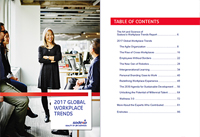A holistic approach to workplace well-being
Interview with Dr. Glorian Sorensen, Director and Principal Investigator of the Center for Work, Health and Wellbeing at the Harvard T.H. Chan School of Public Health.
 Sodexo 2017 Global Workplace Trends Report is hot off the press with ten major trends that will impact our workplace today and in the years to come. Today we sat down with Dr. Glorian Sorensen, Director and Principal Investigator of the Center for Work, Health and Wellbeing at the Harvard T.H. Chan School of Public Health, to talk about the shift towards comprehensive health and safety practices in the workplace.
Sodexo 2017 Global Workplace Trends Report is hot off the press with ten major trends that will impact our workplace today and in the years to come. Today we sat down with Dr. Glorian Sorensen, Director and Principal Investigator of the Center for Work, Health and Wellbeing at the Harvard T.H. Chan School of Public Health, to talk about the shift towards comprehensive health and safety practices in the workplace.
Would you provide a bit of background on your work with the Center for Work, Health and Wellbeing and the Total Worker Health program?
Dr. Glorian Sorensen: We focus on finding ways in which policies, programs and practices can protect workers against work-related hazards and injuries while also promoting the overall health and well-being of employees. We make it a point to look at working conditions and try to understand how a range of on-the-job factors could have a real impact on health outcomes.
From the occupational safety and health perspective, there’s a long tradition of looking at occupational injuries and illnesses that might be related to slips, trips and falls and exposures to hazards; but we recognize that the work environment also impacts the risk of non-communicable or chronic diseases, as well as mental health outcomes. For example, harassment on the job is associated with psychological stress and poor sleep habits are associated with a range of health outcomes including obesity.
Would you say that there is an overall shift in the workplace towards a more holistic approach to worker health and well-being? If so, what is your take on that?
Dr.G.S.: Today there are certainly many organizations, practitioners and academics that continue to focus on a traditional health promotion approach. However, I feel that a more comprehensive approach is extremely important. We need to recognize that when people are at work, their health behaviors, as well as their overall health and safety risks, are very much associated with what they experience on the job. So, the social context matters, the physical context matters, the workplace experiences, the job environment – all of that makes a difference. If we offer programs that address certain health behaviors without recognizing those broader factors that hugely influence health behaviors or safety risks, we’re missing a huge opportunity to be effective. At the center, we focus on marrying the traditional occupational health and safety approach with an expanded understanding of the ways in which work influences a range of health outcomes for workers.
Our work has also started to look not only at worker outcomes but how employers might view these outcomes. We are beginning to look at how some of these same factors influence work absences or turnover rates, healthcare costs, other related factors that are clearly important to employees but also a major concern for employers. For example, we’ve studied the effects of bullying or harassment in the workplace and its relation to increased mental healthcare claims. This is just one small example where we see that workplace experiences may matter in terms of cost outcomes – whether directly measured through healthcare costs, costs associated with absence or presenteeism, turnover, as examples.
Can you think of any areas that need improvement?
Dr.G.S.: In some ways, we’ve focused so much on risk and prevention and maintaining a minimum level of health, but maybe we haven’t paid as much attention as we could have to ensuring that workers are actually thriving. What does it take to be really happy at your job and enjoy being there? I think there’s an increasing need to expand our focus to look at positive elements – not just addressing some of these negative aspects. For instance, let’s not just focus on reducing bullying, but rather creating an environment where people really look forward to coming to work.
In terms of measuring success, this field has been so used to thinking about ROI. Is there another way to measure success in this type of new holistic well-being environment?
Dr.G.S.: Experts in the field are increasingly saying let’s not just look at the costs but let’s look at the added value. Sometimes the added value goes beyond what you see in terms of cost – especially when that value includes factors such as improved morale or the designation of being a company that positively draws talent.
Let’s zoom out and look at this issue on a global scale. Do you see differences around the globe?
Dr.G.S.: We’ve been having conversations with people in a lot of different places. In Europe, they have been thinking about some of these organizational level factors and thinking about the psycho-social dimensions of work for a long time. Colleagues in Australia are taking an integrated approach to addressing the conditions of work as a core component of their approach – not only of safety but of health outcomes as well. We are working closely with people in Chile and Brazil around some of these approaches as well. These are examples of the growing global conversation moving in this direction.


